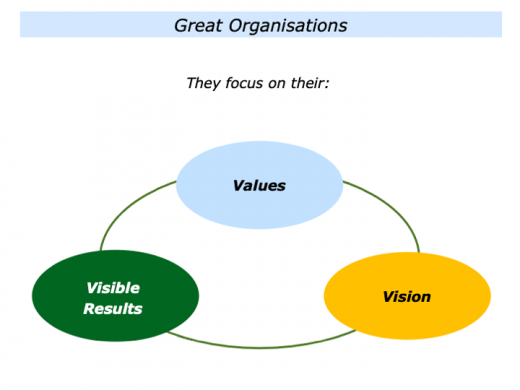
Imagine that you have been asked to help an organisation to clarify its values. The organisation then aims to follow these values, translate them into a clear vision and deliver visible results.
Great organisations are serious about taking this step. They provide a set of guiding principles that people can refer to every day. They aim to live the values rather than just laminate the values.
Such organisations encourage people to focus on this common compass when making decisions or doing their daily work. They also share success stories about how people have translated the values into action.
During the past 50 years I have worked with many organisations that wanted to take this route. When doing this it has been important to adopt the organic approach.
This involves ensuring the values build on when people in the organisation have performed at their best. Such an approach stands the greatest chance of success.
Different organisations obviously develop different values. Below is a combination of the values created by some of the organisations with whom I have worked.
These values may sound simple, but the organisations actually translated them into daily action. The values included:
Take Responsibility … Earn Trust … Be Brilliant … Pioneer The Way … Encourage People … Help Others Succeed … Share Knowledge … Give Great Service … Keep Improving … Deliver Success.
“But those values are not unique,” somebody may say. “Any organisation could say they have those values.”
Great organisations are unique, however, inasmuch that they live their values. Like peak performers, they actually do what they say they are going to do. This is what makes them different.
Looking at my own work on this theme, it has been important to invite the key leaders to consider the implications of going the values route. It has then been to ask them:
“Are you serious?”
There are many pluses to focusing on values but there are also potential minuses. Here are some of these.
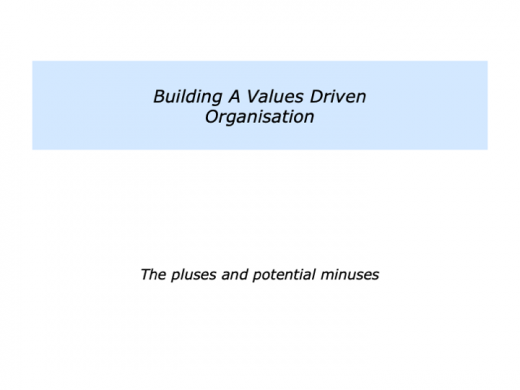
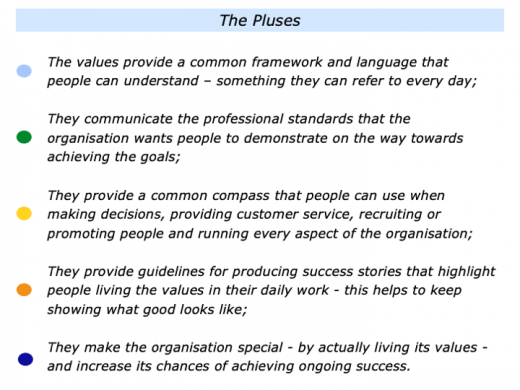
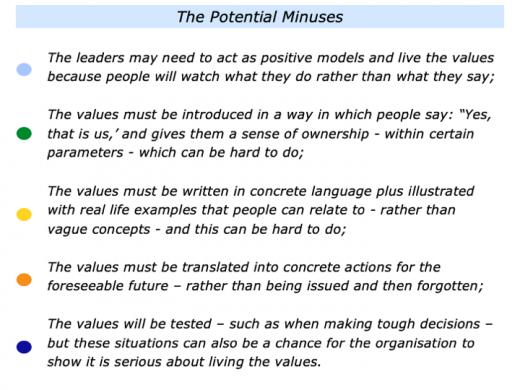
Similarity Of Spirit And
Diversity Of Strengths
There is another reason for focusing on values. Great organisations are often made up of people who have similarity of spirit and diversity of strengths. Diversity of spirit is a recipe for disaster.
Such work places start by defining the spirit – the values or principles – they want people to demonstrate. They get the right people with the right attitude.
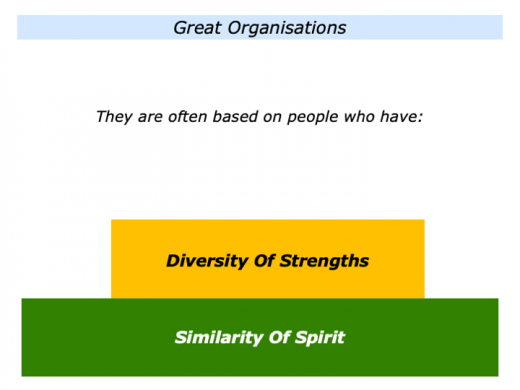
Attitude is non-negotiable, but they want characters, not clones. People will express the spirit in many different ways, but they must always demonstrate high professional standards.
Spirit gets people so far. But it is the diversity of strengths that enables the team to produce something special when it matters.
Every organisation is different, but three themes consistently emerge regarding the required spirit. Different places use different wording, but here are the recurring themes.
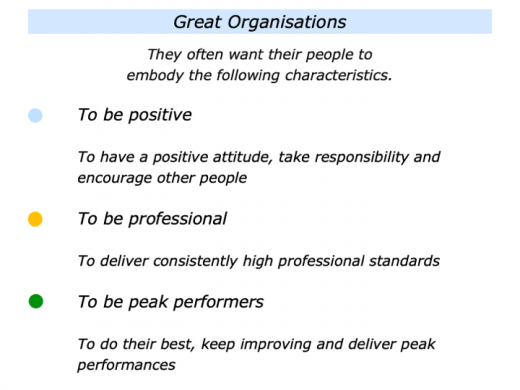
Clarifying The Values
Imagine that you have been invited to help an organisation to clarify and follow its values. There are several ways to make this happen. Each route has both pluses and minuses.
One point is worth underlining. The leaders need to take charge of developing and then living the values. They are accountable for running the organisation.
Employees will watch what these people do rather than what they say. The leaders must therefore believe in the values and see these as the basis for shaping the future.
This does not mean that the leaders go into a bunker and emerge to email the values to everybody else. And it certainly does not mean they hire a marketing company to come up with the values.
The leaders need to craft the values in an organic way. The values must build on the organisation’s strengths yet also provide the basis for shaping a successful future.
The leaders can also involve a wider group of people in shaping the values. This must be done properly, however, to give people a sense of ownership within certain parameters.
Imagine that are helping an organisation to craft its values. Here are three options for taking these steps. There are, of course, other approaches you can take to clarifying the values.
The Positive History Approach
You can develop the values by focusing on when the organisation has performed brilliantly. Looking back at the organisation’s positive history, you can clarify several things.
The specific times when people in the organisation have performed brilliantly;
The specific principles people followed then to perform brilliantly;
The specific things people can do to follow these principles – plus maybe add other things – to perform brilliantly in the future.
You can then make these principles the basis for shaping the organisation’s values.
The pluses of this approach are:
It is organic and builds on the organisation’s strengths. It can be a superb way of involving key people in clarifying the values. It is believable. When the values are presented, you can point to the times when people have followed them successfully.
The potential minuses are:
It may be important to add other principles that people may need to follow to be successful in the future.
The Positive People Approach
You can focus on the employees who embody the behaviours the organisation wants people to demonstrate in the future. You can take this approach by clarifying the following things.
The specific employees who the organisation believes embody the values the organisation must demonstrate in the future;
The specific ways that these people translate the values into action;
The specific values that the organisation can build on to be successful in the future.
The pluses of this approach are:
It is based on real people and can therefore lead to highlighting concrete examples. It is believable. When the values are presented, you can point to people and teams who have followed the values successfully.
The potential minuses are:
It may be limiting in terms of the values it reveals. It can sometimes focus only on the star players. So it is important to highlight the soul players – and the qualities they demonstrate – that make sure the engine of the organisation keeps running.
The Blank Piece
Of Paper Approach
You can start with a blank piece of paper and invite people to clarify the values they believe the organisation must demonstrate in the future. They can brainstorm and agree on the following things.
The specific values they believe the organisation should follow in the future;
The specific ways these values can be translated into action;
The specific ways the leaders are going to live the values and then ensure the values are lived throughout the organisation.
The pluses of this approach are:
It can be appropriate if the organisation needs to be transformed in order to be successful. It puts the emphasis on the leaders being good models and living the values. It can provide a compass that enables the organisation to be successful in the future.
The potential minuses are:
It is not organic. The values may be taken from outside the organisation rather than from within. On the other hand, this may be exactly what is required to transform the organisation.
The Positive Mantra Approach
This is an approach often used by teams involved in sports, expeditions or working together on other projects. It can be an effective and quick way to begin developing a certain culture. Let’s look at one example.
One football manager gathered the whole squad together for a pre-season workshop. People were then invited:
To recall when they had done positive work in a team;
To agree on three words they wanted to have as their positive mantra;
To focus on how they could translate this positive mantra into action in different situations.
The entire squad brainstormed the possible words. These included word such as: together, resilient, supportive, classy, excellent, relentless plus many others. They then voted on these to produce the top three words.
People formed small groups to clarify how they as players and staff could translate each of these words into action. They then focused on how to follow their chosen words in challenging situations.
The squad settled on their final positive mantra – which comprised of three words. They put this in their dressing room and around the training ground. It replaced the old cut-and-paste motivational slogans.
People felt ownership of their mantra. Simple and memorable, it provided a guide they could follow when things got tough during the season.
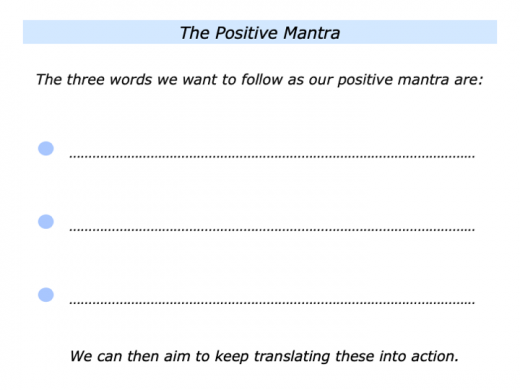
The pluses of this approach are:
It is a quick yet effective way of setting the tone and beginning to build a culture. People feel a sense of ownership by producing their own positive team mantra.
They can then focus on how to translate these into action in real situations. The mantra can also act as a quick call to action – a reminder of how to behave – when they are working towards a goal.
The potential minuses are:
The leaders must set the scene properly and show they are serious about involving people in producing the mantra. They also need to show how it relates to building a certain culture.
If some participants refuse to take it seriously, it won’t work. Of course, such people should not be part of the culture.
The Actual Process Of Helping An
Organisation To Agree On Its Values
Imagine that the leaders in the organisation have chosen to pursue a particular approach to clarifying the values. Here are some things to bear in mind when helping them to take this step.
The number and
wording of the values
Some organisations produce values statements that end up as long tracts full of good intentions and complicated sentences. Here are some guidelines that seem to work.
It can be useful:
To have a maximum of four values – because this make them easier to remember;
To have a maximum of three words per value – because this makes them sharper;
To start each value with a verb – because this provides a call to action.
Good organisations often follow these rules. They also, if appropriate, expand on each of the values and bring them to life with real examples.
The methods for
agreeing on the values
Imagine that you are helping the leadership team to begin clarifying the organisation’s values. There are many ways to take this step. Here is one approach you can take.
Step One
You can invite people: a) to recall specific situations in the past when people in the organisation have performed brilliantly; b) to clarify the values that people followed then and how they translated these into action.
This can help to clarify the values that are demonstrated by people when they perform at their best. It can also provide food for thought when they take the next step.
Step Two
You can give each person four big strips of paper. You can then invite each person to write four values that they believe it is important for people in the organisation to follow in the future.
They are to write one value per piece of paper. When writing the values, they are: a) to start each value with a verb; b) to have no more than three words per value.
If people ask for a guide regarding the areas to cover, it can be worth mentioning that some organisations focus on the following themes when clarifying their values.
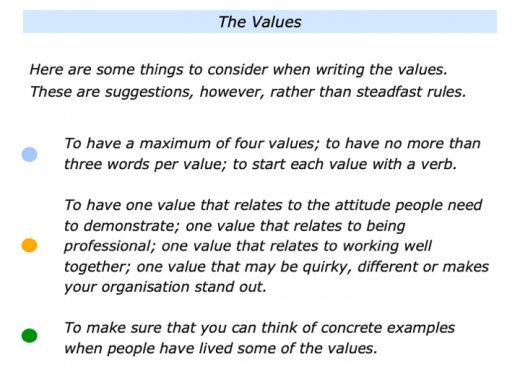
Imagine people have finished writing their suggestions. You can ask each person to go up in turn and put their four pieces of paper – their suggested values – on the floor. They are also to explain the reasons they have written their suggested value.
If you have ten people in the group, you will end up with 40 pieces of paper on the floor. Many of the values will appear to be similar, but that is okay.
Step Three
You can then invite people to vote on their preferences regarding the values. This can be done in various ways. One approach is to give each person four Post-it Notes. These are weighted in the following way:
One Post-it is worth 10 points and they can put this on their first choice value.
One Post-it is worth 8 points and they can put this on their second choice value.
One Post-it is worth 6 points and they can put this on their third choice value.
One Post-it is worth 4 points and they can put this on their fourth choice value.
Invite people to all go up together and place their votes on their four chosen preferences. They can vote for the value they suggested and for other people’s suggestions.
You can again remind them not to worry about any values that look similar. They are to put their votes on their preferences and any overlaps will be worked out later. People will vote and there will be lots of Post-it Notes on the various pieces of paper.
You can then invite people to add up the total votes on each of the values and write the total number on each of the papers. This will result in some values having lots of cumulative votes and others not so many.
Looking at the votes, invite people to see if there are any similar looking values that have quite a lot of votes. If so, people can consolidate these under the value that has the most votes.
The aim is to try to produce four – or at the most five – headings that cover most of the things that have been written by people.
My own experience is that people often produce about five or so main headings. This is okay. After the next step, however, they often find a way to consolidate these under fewer headings.
Step Four
Imagine that people have sorted the paper strips into columns. You can then lead a discussion that will result in settling on the values.
You can draw interrelated circles on a flip chart and aim to fill these with the agreed values. You can then ask people:
“Which is the value with the most votes?”
Write this in the top circle on the flip chart. You can also invite people to discuss which other values they have mentioned that might fit under this heading.
Move onto the value with the second most votes and repeat the process. Continue until all the circles have a value written in them.
Explain to people that these are still provisional values. They are not to be too concerned at this point about covering every eventuality or about wordsmithing.
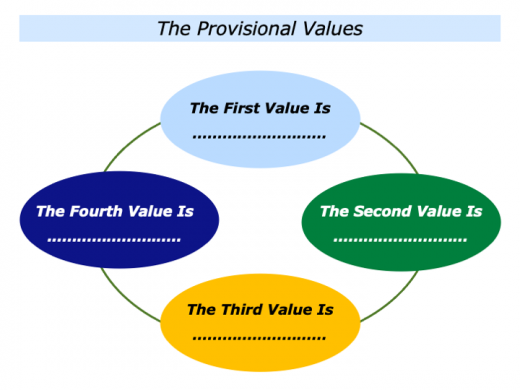
Step Five
You can continue the discussion until it feels like people are reasonably happy with what has been produced. You can check this by saying some of the following things.
“Looking at the values, let me ask you a few things to check if they fit for you.
“Do the values feel right for you? Can you think of people in the organisation who embody some of these values? What do they do to demonstrate some of the values in action?
“If you were to show these provisional values to people in your organisation, do you think that some of them would say: ‘Yes, that is us?’”
You can again emphasise that this is the start of the process and it will be possible to expand or add to the values. At a certain point, however, you may want to move on to focusing on how people can translate the values into action.
Clarifying the specific things people
can do to demonstrate the values
Imagine that the leadership team has settled on some provisional values. You can invite them to do some in-depth work on exploring the implications of introducing the values. They can focus on each of the values and clarify the following things:
The specific things they as leaders can do to translate the value into action;
The specific things that their people can do to translate the value into action;
The pluses and potential minuses of having this value;
The specific things they can do to build on the pluses and minimise the minuses;
The specific things they can do to encourage their people to live the value.
If there are four values, invite them to form four groups and complete the following exercise. They can then present back their findings to the whole group.
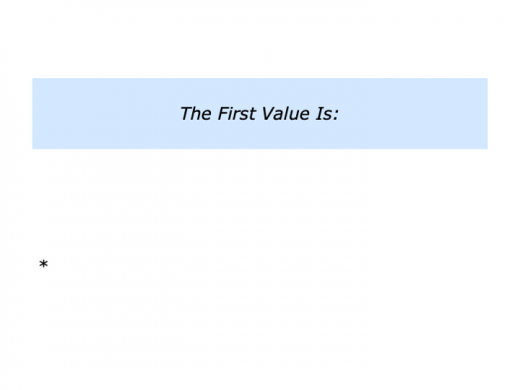
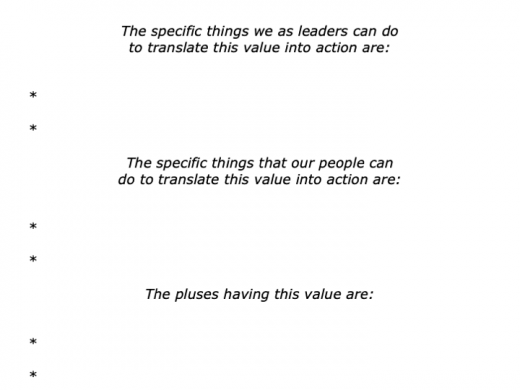
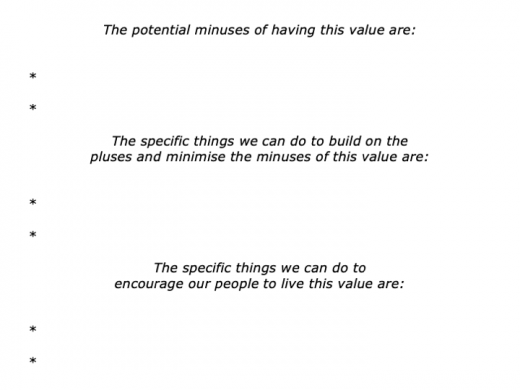
Imagine the leaders have done these exercises and discussed the implications of following the values route. It can then be useful to invite them to make a considered decision regarding if they want to take the next step.
You can again ask them to reflect and decide if they are serious. If appropriate, you can explain this in the following way.
Are You Serious
“We have done some work on clarifying the values. There may be some more work to do on these, but before doing so it is important to consider the following things.
“Bearing in mind the pluses and minuses involved, do you want to move forward with the values approach?
“If so, we know there are certain things that work when pursuing this route. It will be important:
“To polish the work done on the values and prepare these properly before presenting these to your people in the organisation;
“To involve people in fleshing out the values – perhaps through values in action workshops which, when run properly, can be helpful in involving your people;
“To clarify the concrete things you can do quickly to show you are serious about living the values in the organisation.
“We can focus on what works when taking these steps. Before then, however, it is important to go back to one of the original themes.
“Bearing in mind the benefits and possible challenges, are you serious about going the values route? If so, we can move on to making an action plan.”
Communicating The Values
To People In The Organisation
Imagine that the leaders want to go ahead and pursue the values route. One of the most effective ways is by involving their people in values in action workshops.
This will involve the leaders introducing the values to people. When doing so, it can be useful for them to bring the values to life with photographs of staff members who have demonstrated them in the past. People need to be able to look at the values and say:
“That is us.”
Different leaders introduce the values workshops in different ways. One approach is for them cover the following themes in their own way at the start of the sessions.
Values In Action – Introduction
“Welcome to today’s session on values.
“As you know, we have been focusing on the values that we believe it is important for us to continue to follow in the future.
“Today is about sharing those values and giving you the chance to show how we can live them in the future.
“These values are mostly based on the times when people in the organisation have done superb work. We will invite you to do an exercise on this theme early in the workshop.
“We will then introduce each value in turn. When doing so, we will aim:
“To highlight how people have demonstrated this in the past;
“To focus on how we can live this value in the future.
“There are, of course, pluses and minuses involved in aiming to follow certain values. We will be honest about these. We will also look at how we can build on the pluses and minimise the minuses.
“We are sure that many of you have been to sessions where initiatives have been started and then petered out.
“We will therefore conclude the session by describing the specific things we will do to show we are serious about following the values.
“We are serious about maintaining the momentum so that, this time next year, you can look back and say:
‘We have an organisation that is really serious about living its values.’
“Bearing that in mind, I will hand over to the facilitator.
“They will start by highlighting the importance of building values driven organisations.
“They will then invite you to do the exercise regarding when you have seen people in the organisation doing superb work.
“Enjoy the day.”
The values in action workshops usually involve mixing people from different departments. They are interactive and involve a combination of short inputs, exercises and people working on fleshing out the values. Here is an overview of the themes covered during such sessions.
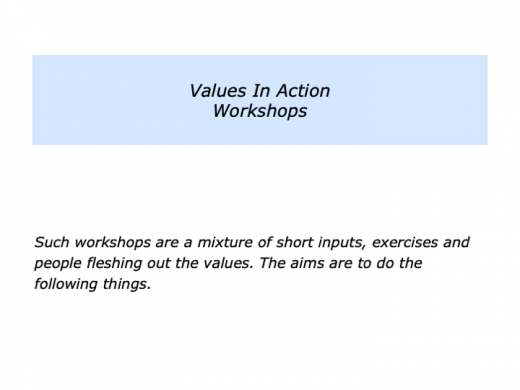
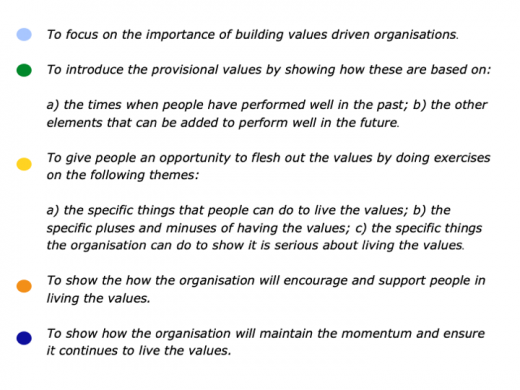
Maintaining The Momentum
Great organisations show they are serious. They recognise that some people may say:
“The values approach sounds fine, but how do you maintain the momentum? Many people have been through values programmes, only for the approach to die a death within a few months. Then people wait for the next initiative.”
Such organisations use many methods to maintain the momentum. These include some of the following.
They keep focusing on the values – especially when making decisions.
They continually publish success stories that show how people are living the values.
They recruit, promote and reward people who embody the values.
They never walk past a quality problem and instantly tackle any form of behaviour that goes against the values.
They ensure the values are embodied in every aspect of running the organisation – such as recruitment, interviewing, induction, the web site, management style, performance management, customer service and other aspects.
Sounds tough? Maybe, but it can be even harder to lead an organisation where people’s values are not aligned.
One of the keys is to be absolutely clear before pursuing the values approach. People are more able to follow the common compass when times get tough.
As mentioned earlier, great organisations then live the values rather than just laminate the values.







Beautiful Mike. I so enjoyed working with you on some of these projects so many moons ago now. This thinking has been at the heart of the Brighton and Spurs culture programmes that have won so many awards. Congratulations on such a profound legacy.